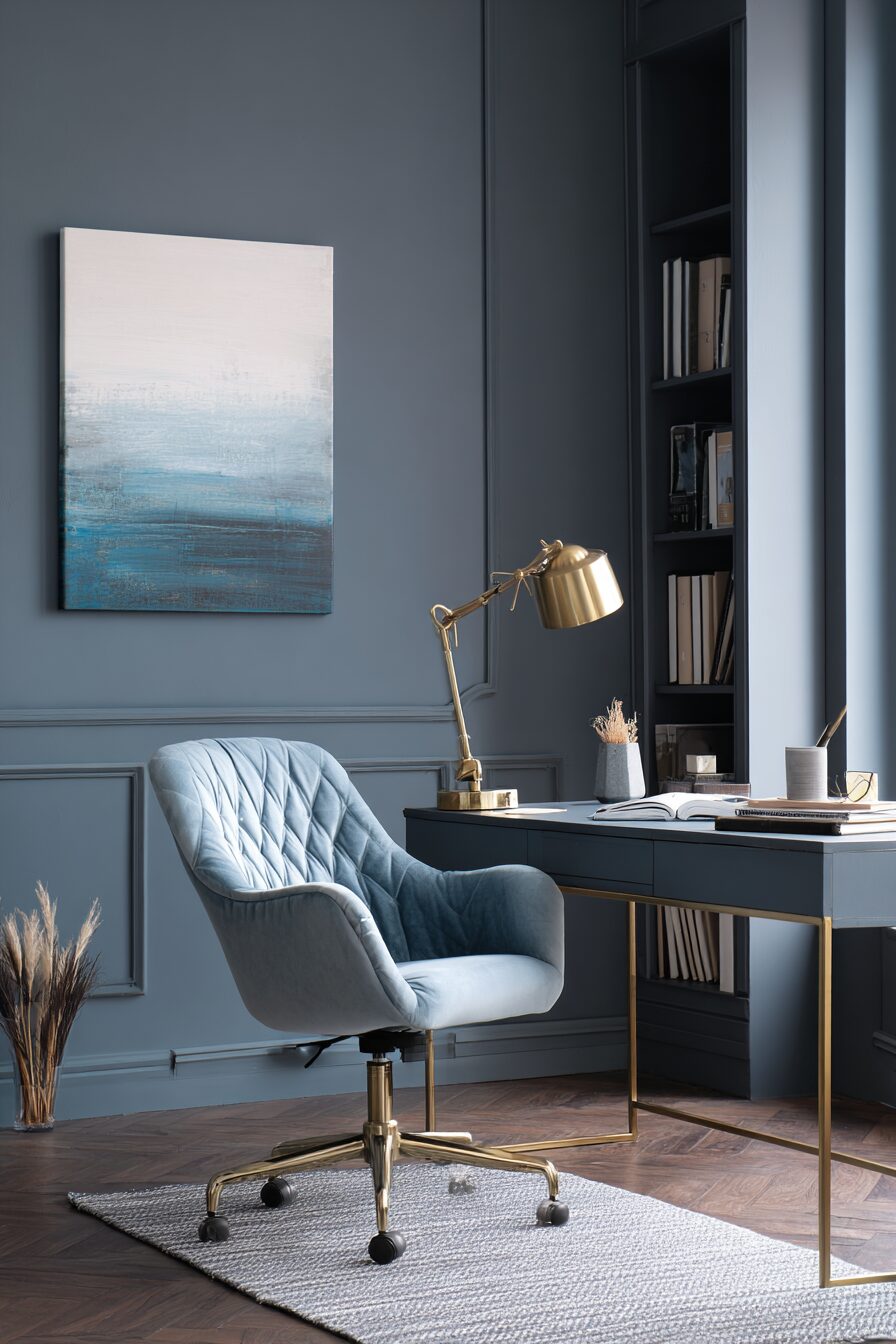Working from home should never mean sacrificing style for functionality.
Your home office deserves the same thoughtful design as the rest of your living space.
Here are top decor ideas that will transform your workspace into a productivity paradise that perfectly reflects your personal style.
The Statement Desk That Commands Attention


Every powerful workspace begins with the perfect desk that serves as both your command center and style anchor.
Selecting a desk that makes you feel confident and capable can transform your entire work experience.
Choose a glass-topped desk with gold or brass legs for a luxurious contemporary vibe that brightens your space.
Wooden desks with clean lines offer timeless appeal while providing the durability needed for daily use.
For smaller spaces, floating desks that mount directly to the wall create the illusion of more floor space while maintaining functionality.
L-shaped or corner desks maximize surface area and create natural work zones for different tasks.
The color of your desk significantly impacts the room’s overall feel, with white creating airiness, dark woods adding sophistication, and painted finishes introducing personality.
Hardware details like ornate drawer pulls or sleek modern handles can elevate an ordinary desk into something extraordinary.
Don’t overlook the importance of proper height and proportions that accommodate your specific work requirements.
Desks with built-in storage solutions help maintain organization without requiring additional furniture pieces.
A vintage desk or secretary can introduce character and conversation-starting appeal to your workspace.
Remember that your desk represents your professional identity within your home, so choose one that reflects your ambitions and aesthetic preferences.
Lighting That Transforms Mood and Productivity
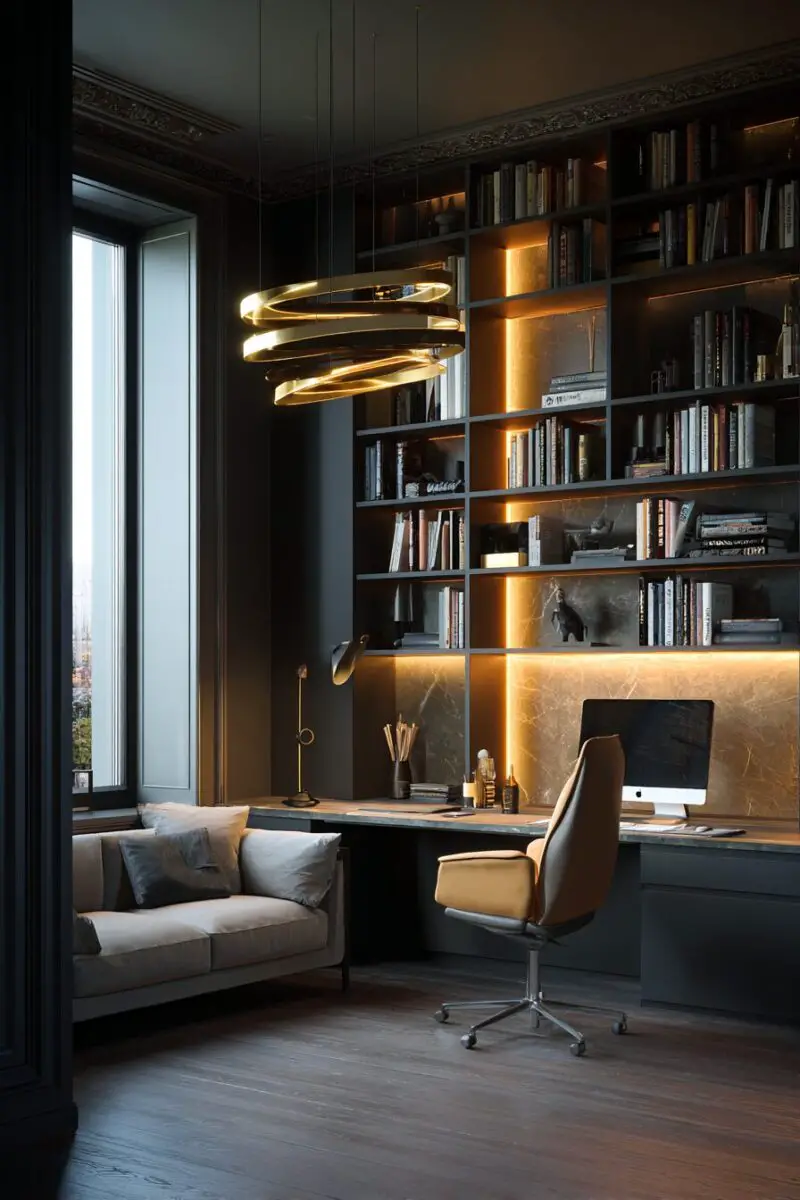
Strategic lighting serves as both functional necessity and design statement in any effective home office.
Natural light should be your primary source whenever possible, positioning your desk to maximize window exposure without creating screen glare.
Layer multiple light sources rather than relying on a single overhead fixture to create depth and eliminate harsh shadows.
A stylish desk lamp with adjustable brightness provides targeted task lighting exactly where you need it most.
Statement lighting fixtures, like an elegant pendant or chandelier, can serve as the room’s centerpiece while expressing your personal style.
Wall sconces save precious desk space while adding symmetry and sophistication to your office design.
Smart lighting systems allow you to adjust brightness and color throughout the day to match your energy levels and tasks.
Don’t underestimate the impact of proper lighting on video call appearance, with ring lights or well-positioned lamps significantly improving your professional image.
Incorporate candles (real or flameless) for ambient lighting during evening work sessions or when seeking a calmer atmosphere.
Floor lamps can illuminate darker corners while adding height variation to your office design.
Choose lighting with built-in USB ports or charging stations to maximize functionality.
String lights or LED strips can add whimsical touches and indirect lighting that softens the overall environment.
Design Your Dream Room in Minutes!
🏡 Start Creating FREE →Ergonomic Seating That Doesn’t Sacrifice Style

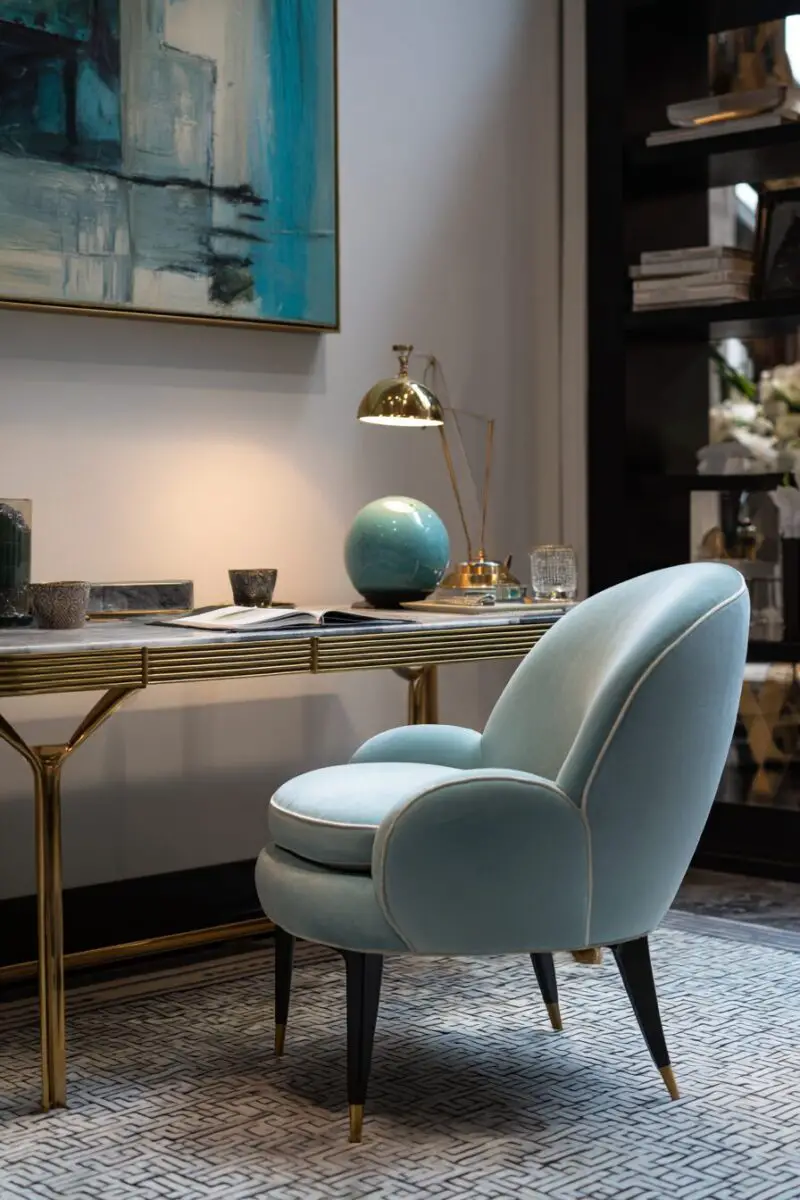
The perfect office chair balances comfort, support, and aesthetic appeal, serving as both functional necessity and design statement.
Traditional ergonomic principles need not result in clunky, corporate-looking seating options.
Choose chairs upholstered in luxurious fabrics like velvet or bouclé that introduce texture while maintaining proper back support.
Color selection for your chair offers opportunity for either complementary harmony or striking contrast within your office palette.
Adjustability features remain non-negotiable, with height, armrest position, and tilt functions ensuring proper alignment regardless of your frame.
Accent chairs can serve as secondary seating for clients or reading spots that enhance your office’s residential feel.
Acrylic or ghost chairs provide ergonomic support while visually disappearing in smaller spaces.
Vintage wooden chairs updated with cushions combine character with comfort for unique seating solutions.
The material of your chair impacts not just appearance but temperature regulation, with mesh providing breathability in warmer environments.
Lumbar support pillows in coordinating fabrics allow personalization of support while introducing additional texture and color.
Rolling capabilities provide necessary mobility, but consider rubber wheels that protect hardwood floors.
Armrest design impacts both comfort and desk clearance, with adjustable options providing maximum flexibility.
Chair mats protect flooring while enhancing mobility on carpeted surfaces.
TRENDING NOW
13 Home Office Decor Ideas To Elevate Your WorkspaceGallery Walls and Inspiration Zones That Spark Creativity
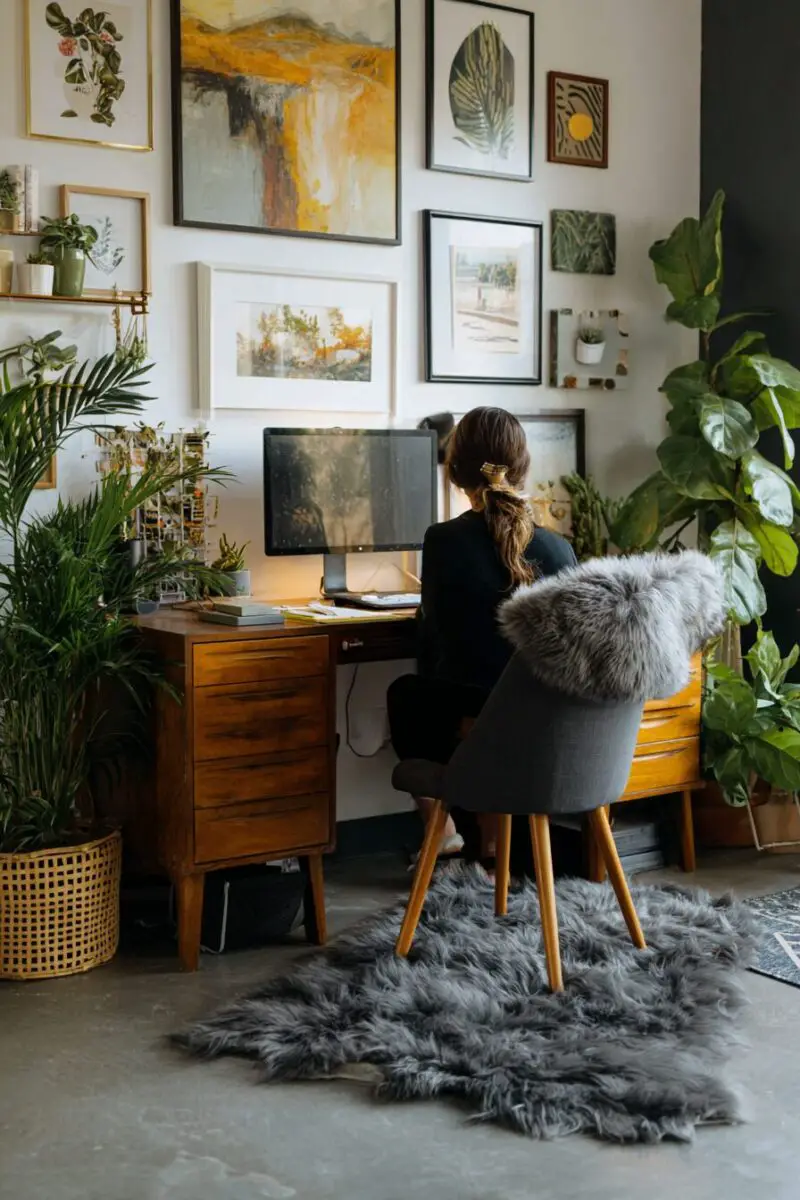
Surrounding yourself with visually stimulating elements can transform productivity and infuse your workspace with personality.
Create a gallery wall that mixes professional achievements with personal inspirations to maintain motivation during challenging workdays.
Include affirmations or favorite quotes in elegant typography that reinforce your professional values and goals.
Vision boards displayed prominently serve as constant reminders of both short and long-term objectives.
Incorporate artwork that resonates with your aesthetic sensibilities while enhancing the room’s color story.
Professional certificates and credentials displayed tastefully validate your expertise while personalizing your space.
Magnetic or cork boards covered in beautiful fabrics provide practical space for rotating inspiration and necessary reminders.
Family photos in elegant frames maintain connection to your personal life without overwhelming the professional atmosphere.
Floating shelves allow for three-dimensional displays that can be easily updated as inspirations change.
Digital frames rotating through favorite images offer versatility in smaller spaces.
Wallpaper or removable wall decals can create an accent wall that serves as built-in artwork.
Mirrors strategically placed not only make the space appear larger but reflect light and offer quick appearance checks before video calls.
Storage Solutions That Blend Function With Fashion

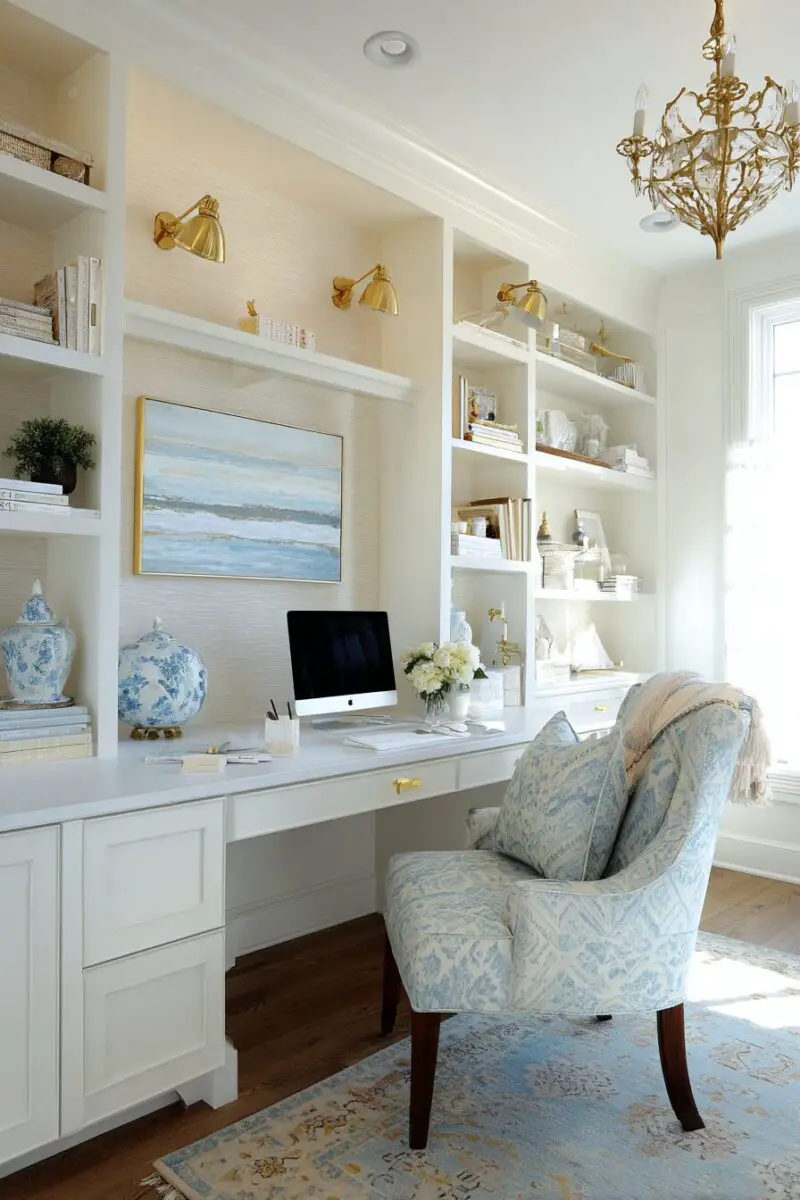
Organizational systems should enhance rather than detract from your carefully designed workspace.
File cabinets no longer need to resemble sterile office equipment, with options available in beautiful woods, painted finishes, and decorative hardware.
Floating shelves installed above your desk provide accessible storage while creating architectural interest.
Decorative boxes and baskets in coordinating materials conceal necessary but unattractive office supplies.
Consider vintage containers repurposed for modern storage, like antique silver cups for pens or ceramic planters for file folders.
Color-coding your storage creates visual harmony while improving efficiency in locating necessary items.
Wall-mounted organizers free up precious desk space while keeping frequently used items within easy reach.
Drawer dividers prevent small item chaos and maintain organization even when storage is out of sight.
Bookshelves styled with a combination of reference materials, decorative objects, and personal mementos create balanced visual interest.
Hidden storage solutions like ottomans with removable tops provide extra seating and concealed storage for less attractive necessities.
Label makers with decorative tapes allow for beautiful organization that enhances rather than detracts from your aesthetic.
Remember that negative space remains important, with some empty areas preventing visual overwhelm.
Multi-functional furniture pieces like desks with built-in shelving maximize space efficiency in smaller home offices.
TRENDING NOW
13 Office-Living Room Combos For Smart SpacesBiophilic Elements That Breathe Life Into Your Workspace

Incorporating natural elements creates a connection to the outside world that reduces stress and enhances creativity.
Even those lacking green thumbs can benefit from low-maintenance plants like succulents, snake plants, or pothos that thrive with minimal care.
Consider the size and scale of plants, with larger statement plants creating focal points and smaller varieties adding accents without overwhelming.
Plant containers offer additional opportunities to introduce complementary colors and textures to your design scheme.
Beyond traditional plants, preserved moss walls or framed botanical specimens provide natural elements without maintenance requirements.
Natural light-loving plants placed near windows create a living privacy screen while improving air quality.
Fresh flowers changed weekly introduce evolving color and fragrance that stimulate the senses.
Natural materials like wood, stone, and rattan incorporated into furniture and accessories ground the space in organic elements.
Water features, even small desktop fountains, introduce soothing sounds that mask household noise and enhance concentration.
Natural fiber rugs add warmth and texture while connecting to biophilic design principles.
Window views should be maximized rather than blocked, allowing visual access to outdoor landscapes when possible.
Nature-inspired artwork can simulate biophilic benefits in spaces where actual plants prove challenging.
Remember that natural light itself counts as a biophilic element, with light-maximizing window treatments enhancing this connection.
TRENDING NOW
13 Day Bed-Office Combos For Ultimate ComfortColor Psychology: Hues That Enhance Productivity and Mood
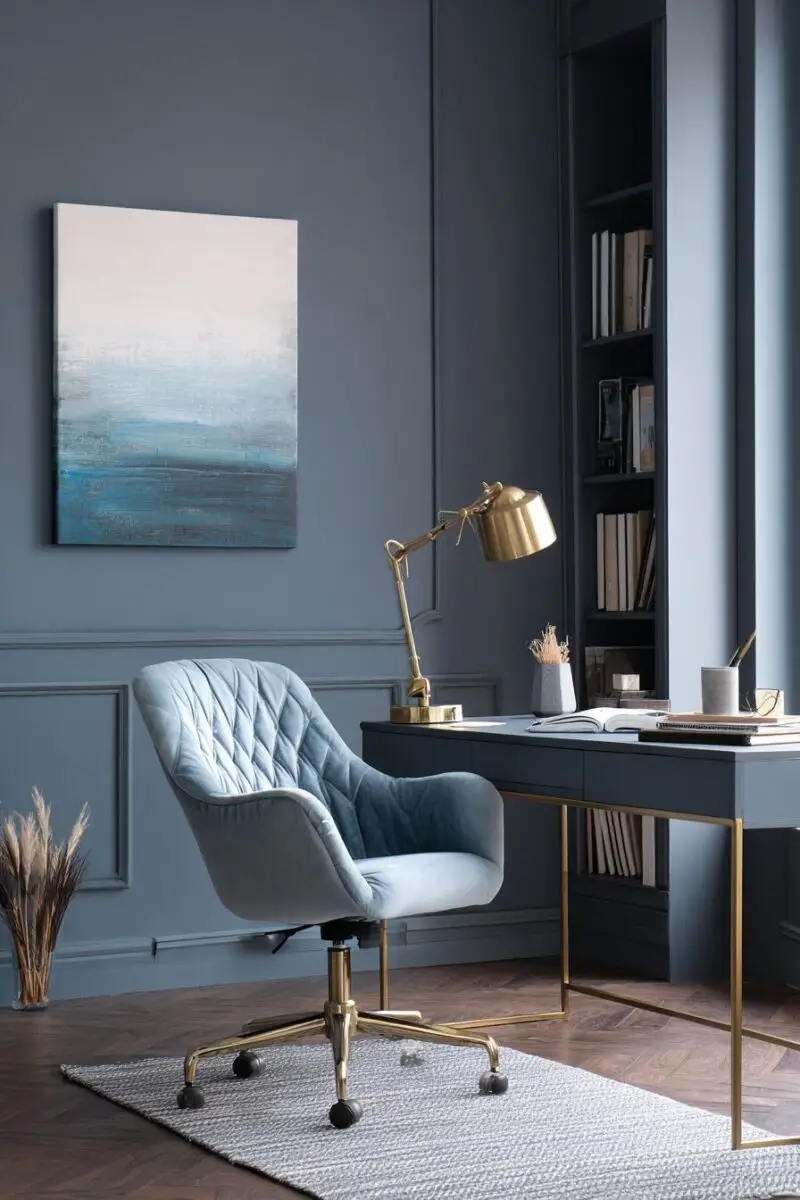
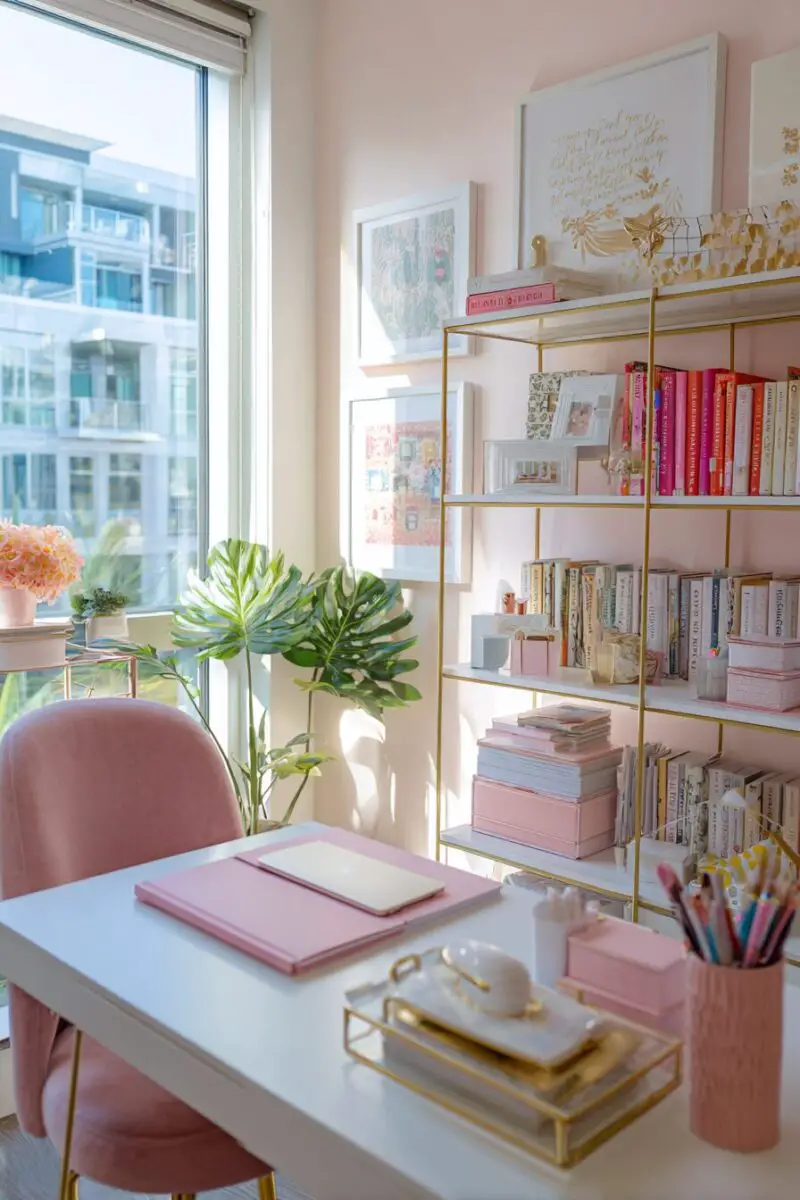
The colors surrounding you significantly impact energy levels, focus, and emotional well-being throughout your workday.
Blue tones promote concentration and intellectual thought, making them ideal for tasks requiring sustained mental effort.
Green creates a sense of balance and harmony while reducing eye strain during long computer sessions.
Yellow introduces optimism and creativity but should be used strategically as accents rather than dominant elements to prevent overstimulation.
Neutral backgrounds allow for colored accessories that can be easily changed when preferences evolve.
Purple traditionally associated with luxury introduces sophistication while stimulating problem-solving abilities.
Pink, contrary to outdated gender stereotypes, can reduce stress and create nurturing environments conducive to thoughtful work.
Color blocking techniques allow for introducing multiple colors while maintaining visual coherence.
Remember that colors appear differently under various lighting conditions, necessitating testing samples at different times of day.
Monochromatic color schemes using varying shades of a single color create sophisticated, cohesive environments.
High-contrast color combinations stimulate energy but may impede relaxation necessary for certain tasks.
The colors in your office should coordinate with adjacent rooms visible from your workspace to maintain whole-home harmony.
Luxury Desk Accessories That Elevate Everyday Tasks

Surrounding yourself with beautiful tools transforms mundane activities into pleasurable rituals that enhance workday satisfaction.
Choose leather desk accessories like blotters, pen cups, and document trays that develop character with use while protecting your desk surface.
Lucite or acrylic organizers introduce contemporary elegance while maintaining visual lightness.
Replace standard office supplies with elevated versions, like decorative paper clips, beautiful staplers, and pens that feel substantial in hand.
A curated collection of writing instruments displayed in a beautiful container creates functional artwork.
Personalized stationery and notepads introduce your personal brand into everyday communications.
Desk clocks with interesting design elements serve both functional and decorative purposes.
Paperweights, beyond their functional purpose, introduce sculptural elements and interesting materials to your desktop landscape.
Technology accessories like mouse pads, keyboard covers, and headphone stands offer opportunities for coordinating with your overall design scheme.
Desk trays designated for specific purposes prevent the accumulation of random items while maintaining visual order.
Bookends that double as art objects keep reference materials accessible while contributing to the room’s design story.
Beautiful containers for necessary but unattractive items like charging cables and thumb drives maintain aesthetic harmony.
Remember that negative space remains crucial, with carefully selected accessories making stronger statements when not competing for attention.
Zoning Strategies for Multi-Function Spaces
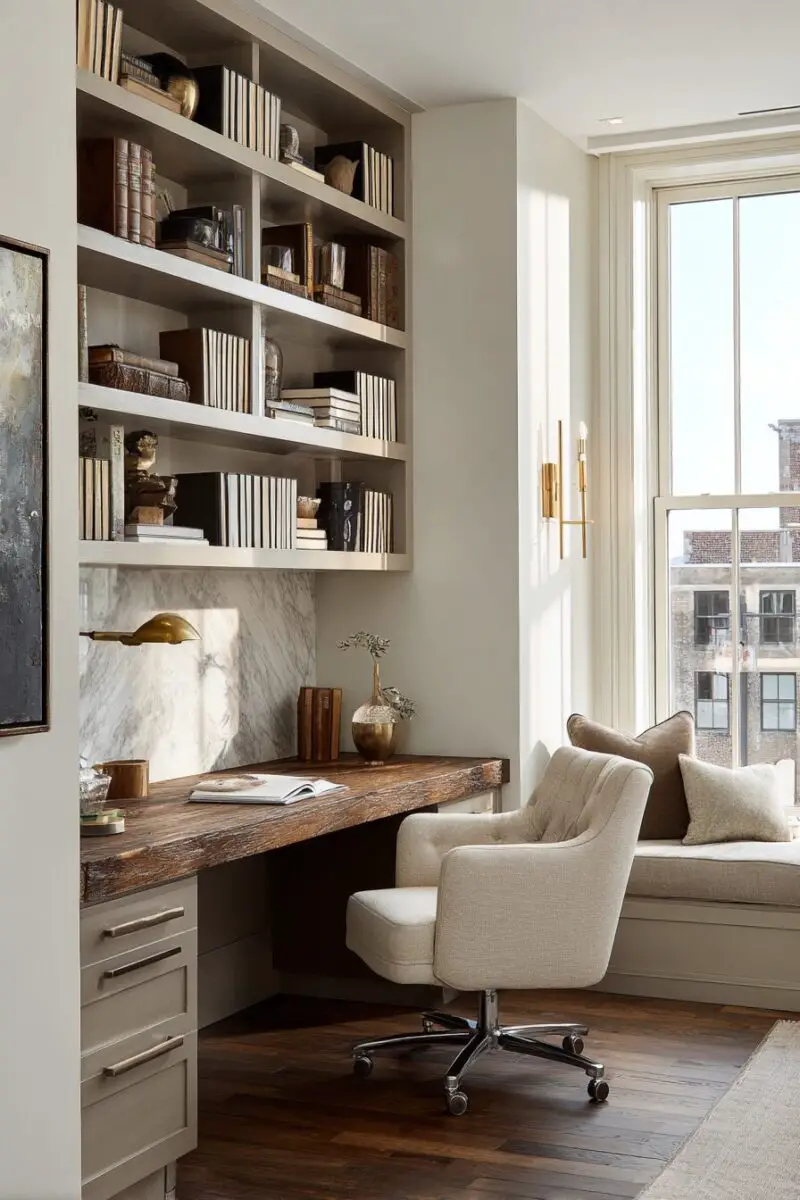
Creating distinct areas within your home office allows for transitioning between different work modes while maximizing available space.
Consider using area rugs to visually define separate zones without requiring physical barriers.
Furniture arrangement can naturally create different functional areas, with your desk as the primary workspace and secondary seating for reading or client conversations.
Lighting plays a crucial role in zone definition, with task lighting at your desk, ambient lighting for transitional areas, and accent lighting highlighting architectural features.
Room dividers like decorative screens, bookcases, or even strategically placed plants can create privacy without sacrificing openness.
Color coding different areas reinforces their distinct functions while maintaining overall harmony.
Storage solutions should be positioned within the zones where those items will be used, minimizing unnecessary movement.
Vertical space utilization becomes critical in multi-function rooms, with wall-mounted elements freeing floor space while maintaining functionality.
Include a dedicated background zone for video calls that presents a professional image without revealing your entire workspace.
Create transition rituals between zones that help signal mental shifts between different types of work.
Put mobile elements like rolling carts that can move between zones as needs change throughout the workday.
Remember that visual coherence across zones maintains a sense of intentional design rather than fragmented spaces.
Flexible furniture that serves multiple purposes allows for adaptation as work requirements evolve.
TRENDING NOW
13 Creative Cubicle Privacy Ideas You’ll LoveTech Integration That Maintains Aesthetic Harmony
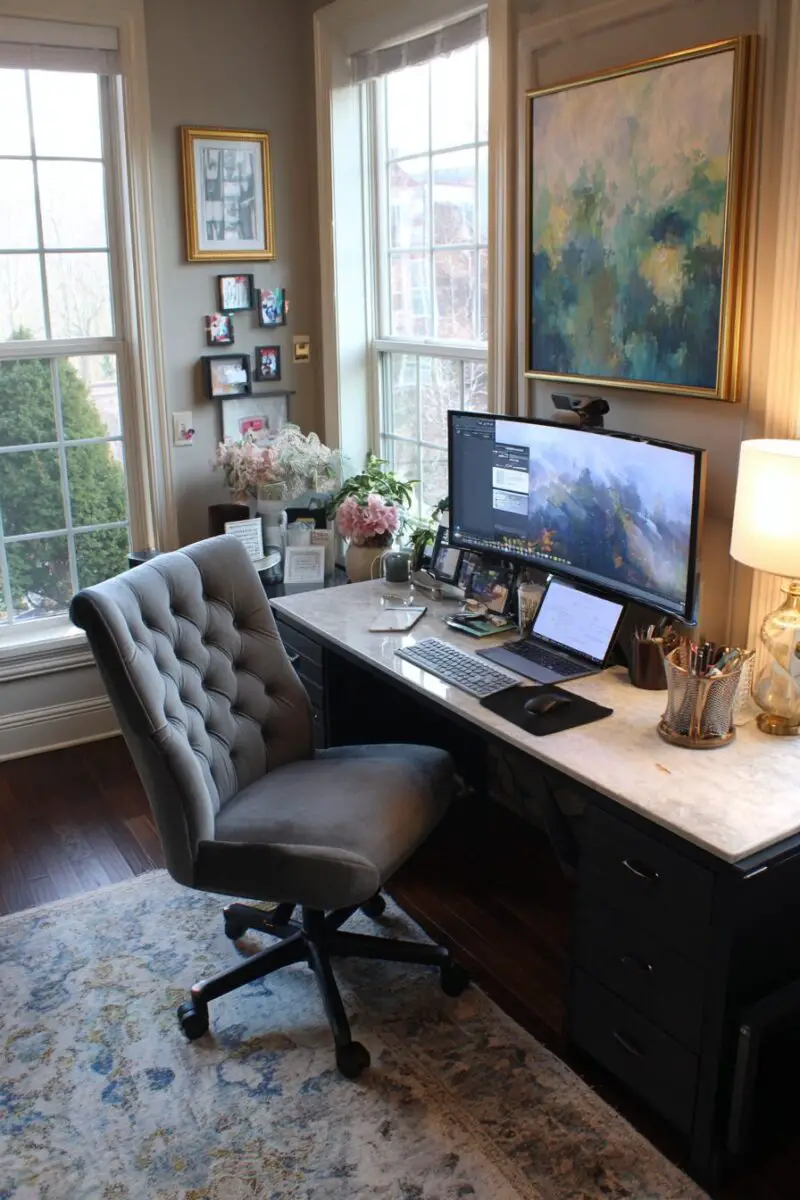
Technology necessities need not detract from your carefully curated office design with thoughtful integration strategies.
Cable management systems, from simple cord clips to more elaborate under-desk trays, eliminate visual clutter while preventing frustrating tangles.
Wireless charging pads integrated into desk surfaces provide power without additional cords.
Decorative boxes and baskets can conceal routers, modems, and power strips while maintaining accessibility.
Position printers and larger equipment on closed cabinets or dedicated carts that contain their visual impact.
Coordinating laptop stands not only improve ergonomics but elevate your computer to art object status.
Bluetooth speakers designed as decorative objects introduce high-quality audio without technological eyesores.
Smart home integration allows for controlling lighting, temperature, and even window treatments without disrupting workflow.
Balance screen time with analog tools like beautiful notebooks and planners that reduce eye strain while enhancing creativity.
Think about monitor frames or decorative surrounds that coordinate with your overall design scheme.
Remember that technology should serve your work requirements rather than dictating your space design.
The best tech integration disappears into the background, allowing your carefully selected decorative elements to take visual precedence.
The most successful workspace designs evolve over time, adapting to changing needs while maintaining core elements that inspire and motivate.
By thoughtfully implementing even a few of these ideas, you’ll create an environment that enhances productivity while making every workday more pleasurable.
Your perfect home office awaits – one that’s as unique and capable as you are.

